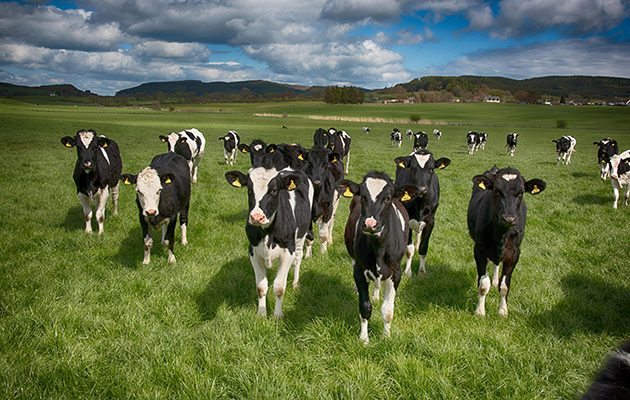While there’s no mass celebration as our winter-housed cows are returned to pasture, their evident delight is just one of the many benefits, as Tim Field explains
The spring turn out
In the Alps the seasonal droving of livestock from winter holdings in the valleys to summer mountain pastures is widely celebrated.
Whilst the Alpine transhumance triggers celebrations of festival proportions, Britain’s farms still show a great deal of gratitude when the grass starts growing and the biting frosts subside. None appear more grateful than our winter-housed livestock, as is evident when a mob of cattle enjoys the spring turn out. Even the most placid of herds finds another level of energy, friskiness and frolics. The prancing around speaks volumes for the cows’ happiness at being on fresh pasture, with crisp air up the nose and sun on their back.
Why is livestock housed indoors over winter?
Most of our livestock have been housed in the winter for their comfort and to rest the soils while vegetative growth ceases. However, the significant cost of feed and bedding is sufficient incentive to get the stock out to the new season’s pasture. The early grazing also stimulates grass growth as temperature and daylight intensity builds.
Many factors determine the timing of animals being turned out – mostly relating to grass availability – and the three greatest influences are spring soil temperature, the grazing regime since autumn and fertility in the soil. Long have farmers tried to manipulate grass growth in spring, through the use of water-meadows, for example. Deliberate flooding episodes deposit fertile river water and silts on the land and the water has an insulating value for the ground beneath. Whilst also saved from grazing pressure, the water is drained at the end of winter, which triggers a flush of spring grass. Few functional water-meadows exist now, which is a shame as they provide an incredible habitat for wetland plants and animals.
Soil temperature
Soil temperature is hard to control but spring pastures should be spared from grazing at the start of October onwards, while a dose of muck can give the pulse of fertility required as the growing season gets underway. Mindful that the muck should have degraded before the stock start grazing, spring grass should then be nurtured, ensuring it doesn’t become overgrazed or poached. As a rule of thumb, the heavier the ground, the lighter the stock that should be grazing it.
The new grass will tantalise the taste buds of dairy cows when they head out but with diet sensitivities being crucial to milk yield and fertility, an over-enthusiastic early spring turnout can present problems. Ensiled feed and winter rations have a relatively consistent nutritional value whereas the sugar content, moisture and protein levels in fresh grass are more variable. For this reason, and to protect the pastures from excessive poaching, dairy cows are given time to graze in a more controlled fashion. At first, the girls are turned out during the day but retained in the barn through the night until conditions suit and the rumen has adapted to a change in diet.
Lambs and ewes
By now, the fields are filling with the bleating of lambs and ewes. Those that haven’t lambed outdoors will be turned out as soon as possible, instantly doing better with fresh air in their lungs. The only proviso being a good piece of shelter in the form of trees, hedgerows or stone walls for the stinging winds that can linger into April, or the unwelcome dump of snow that has been known to greet us as we crack open our Easter Eggs.
The joy of seeing livestock over-excited at the feel of grass under foot reinforces a belief that they should be given access to fresh pasture for the majority of their life. Consumer appreciation of welfare, nutrition and quality in the finished meat and dairy product is clearly getting a vote on this, too, helped by YouTube sharing footage of hundreds of proud farmers with their hysterical stock at spring turn out.
The backdrop of grazing cattle provides all the marketing material needed to direct-sell an ever-growing amount of quality produce. For instance, after a post-war crash in British cheese diversity the nuances of breeds, forage types and seasonality are supporting an exciting revival in our artisan cheese sector. So while we are not renowned for our ski slopes and cow bells, the culture born out of Britain’s dairy paddocks has become world leading; we now produce more varieties of cheese than our cousins across the Channel.
(Try this recipe for game cobbler with smoked cheese scones.)
This article was originally published in 2018 and has been updated.





